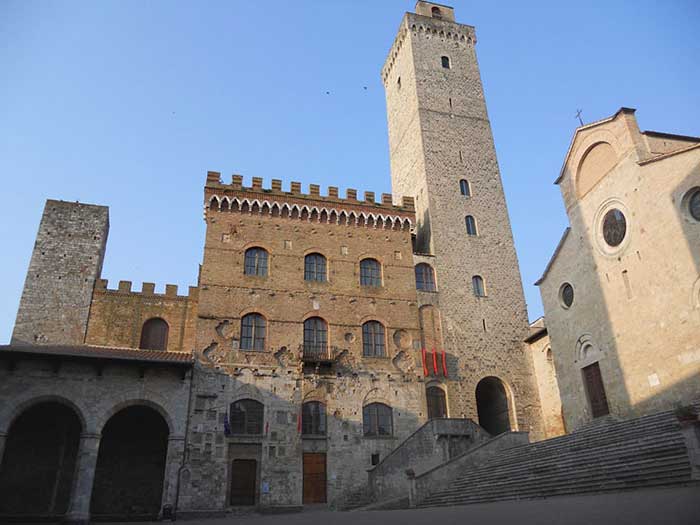| |
|
San Gimignano stands on a hill dominating the Val d'Elsa, immersed in the extraordinary landscape of Tuscany, 56 km south of Florence.
The Piazza del Duomo is the heart of San Gimignano, just as it was the centre of political and religious life in the Middle Ages. Entering Piazza del Duomo from Piazza della Cisterna, on the left you can see the Palazzo Comunale, which stands next to the staircase leading to the entrance of the Duomo. The Basilica Collegiata di Santa Maria Assunta (or Chiesa Collegiata) is a remarkable monument of Romanesque architecture in Tuscany. The church is famous for its fresco cycles which include works by Domenico Ghirlandaio, Benozzo Gozzoli, Taddeo di Bartolo, Lippo Memmi and Bartolo di Fredi. The basilica is located within the UNESCO World Heritage Site of the "Historic Centre of San Gimignano", with its frescos being described by UNESCO as "works of outstanding beauty".[2]
The 12th-century Palazzo Civico has always been the centre of local government; its Sala di Dante is where the great poet addressed the town's council in 1299, urging it to support the Guelph cause, and its pinacoteca has a charming collection of paintings from the Sienese and Florentine schools of the 12th to 15th centuries.
|
|
|
1 |
Piazza della Cisterna |
2 |
Palazzo Tortoli |
3 |
Arco dei Becci |
4 |
Palazzo del Podestà |
5 |
Piazza del Duomo |
6 |
Palazzo del Popolo |
7 |
Museo d'Arte Sacra, Museo Etrusco |
8 |
Torri Salvucci |
9 |
Palazzo Cancelleria |
10 |
Palazzo Pesciolini |
11 |
Palazzo Tinacci |
12 |
San Pietro |
13 |
Piazza Sant'Agostino |
14 |
San Iacopo |
15 |
Porta San Iacopo |
16 |
Porta d. Fonti |
17 |
San Lorenzo in Ponte |
18 |
Porta San Giovanni |
19 |
Porta Quercecchio |
20 |
Porta San Matteo |
View larger map
|
| |
|
|
The Palazzo Comunale, also known as the Palazzo del Popolo of San Gimignano has been the seat of the civic authority in the comune since the 13th century. It is located on the Piazza del Duomo close to the Collegiate Church of the Assumption of the Blessed Virgin Mary. The building and Collegiate Church are at the heart of the medieval town, and are part of the UNESCO World Heritage Site of the "Historic Centre of San Gimignano".[1]
The building contains important fresco decorations by Memmo di Filippuccio, Lippo Memmi and others, a museum and a gallery with works of the Florentine and Sienese schools of art - including paintings by Coppo di Marcovaldo, Lippo Memmi, Benozzo Gozzoli, Filippino Lippi, Il Sodoma and Pinturicchio.
The Palazzo Comunale dates from the late 13th century, and was built on the ruins of an existing building between 1289 and 1298.[2] Further expanded in the 14th century,[3] the facade is characterised by arched windows, with the lower half of the frontage built with stone, and the upper part in brick.
On the ground floor is a courtyard, which was built in 1323[4] and is decorated with the coats of arms of those who have held public office in the municipality.[2] The main civic offices of the town council are now located on this ground floor.[5]
On the first floor is a stepped gallery from which dignitaries would address the gathered crowd in the square. The battlements date from a restoration of the nineteenth century,[3] and the structure is capped by the "Torre Grossa” (great tower). This tower was completed in 1300[5] and (at 54 meters) is the highest tower in the walled town.[2]
|
|
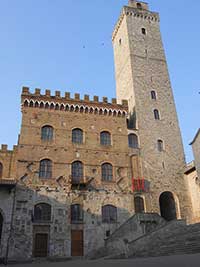
Palazzo Comunale
|
Museo Civico
|
|
|
|
Palazzo Comunale, courtyard
|
| |
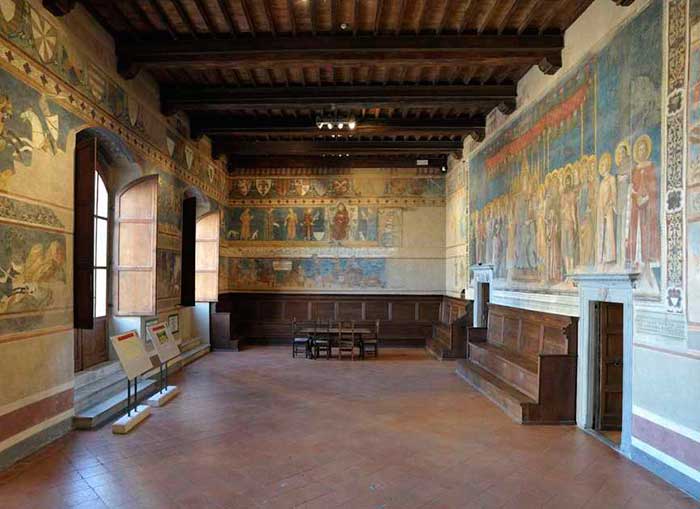 |
Sala di Dante, Museo Civico, San Gimignano
|
The upper stories of the palazzo house the Sala del Consiglio, and (since 1852) the civic museum and gallery. The Sala di Dante (also known as the Sala del Consiglio) is home to Lippo Memmi's early-14th-century Maestà. Other frescoes in the room portray jousts, hunting scenes, castles and other medieval goings-on.
Hall
The Sala del Consiglio is a large reception hall which was used as the council chamber.[2] It is commonly known as the Sala di Dante and is named for the noted poet Dante Alighieri who visited San Gimignano in 1300 as an ambassador of the Florentine Republic.[6]
The room is decorated with a Maestà by Lippo Memmi. Commissioned in 1317 by Nello de Mino Tolomei (then podestà of San Gimignano), the fresco is believed to have been inspired by Simone Martini's Maestà from the Palazzo Pubblico in Siena.[7] The fresco shows Mary seated on a throne surrounded by adoring saints and angels (including patron Nello de Mino Tolomei).[7]
Other frescoes in the room portray jousts, hunting scenes, castles and other medieval goings-on, attributed to Azzo di Masetto.
Azzo di Masetto studied in Cimabue's workshop in the late XIIIth century.
The frescoes quite vivacious and enganging from a narrative point of view, include episodes of courtly life, such as knights battling in tournaments, hunting scenes and, on the wall facing the entrance a depiction of the emperor Charles d'Anjou enthroned amid courtesans and falconers, especially referring his passage in Florence in the same year. This scene probably refers to pacts of alliance between the sorveign and the Chelphs of Florence and San Gimignano, and is intended to memorialise for posterity an occasion of significant relevance for the city.
|
|
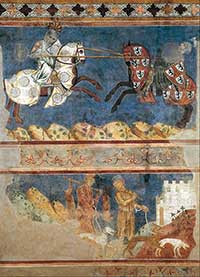
Azzo di Masetto, Tournament and Hunting Scenes (1289)
|
 |
Azzo di Masetto, Tournament and Hunting Scenes (1289)
|
| |
|
|
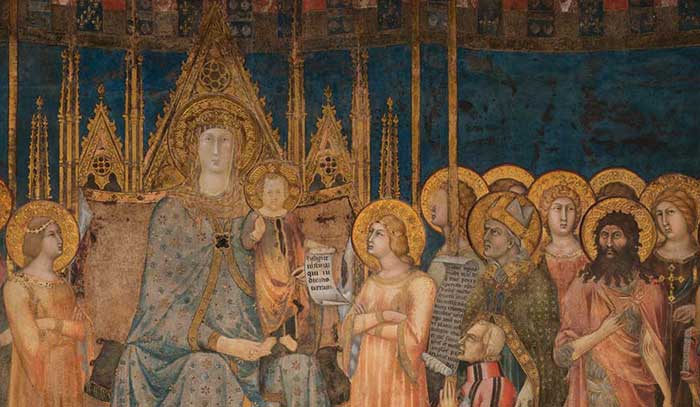 |
Memmi's Maestà in the Sala di Dante of the Palazzo Comunale, San Gimignano
|
The Memmi workshop began with Lippo's father, Memmo di Filippucci. Its early works, such as the 1317 San Gimignano Maestà in the Palazzo Comunale, are a collaboration of the two. Lippo's brother Federigo Memmi belonged to the shop before 1343, during the time the New testament cycle and other works attributed to "Barna of Siena" were produced.
Memmi's Maestà at San Gimignano is striking in the various methods of pastiglia and gilding work used. Golden tin on the throne cusps, laminated tin with gold foil for the halos which are carefully rendered with intricate punchwork, his application of these materials described as “a neat perfection rarely encountered elsewhere”.[12] Examination of the motifs and degree of complexity in the punchwork has allowed historians to recognize the hand of Lippo Memmi and gives a clearer idea of his place in collaborations with Simone Martini. Stamp designs, gilding and the execution of rayed halos are similar, yet show that Lippo Memmi's mature gild and scribe work patterns in the 1317 San Gimignano Maestà are rooted in the simpler patterns and less developed line he applied to Martini's Maestà of 1315 at the Palazzo Pubblico in Siena.[12]
Simone Martini was the brother-in-law of Lippo. After Lippo returned to Siena from Avignon there is little evidence of interaction with Simone Martini.
Just off the great hall is a meeting room which was originally used for private meetings.
Gallery
|
|
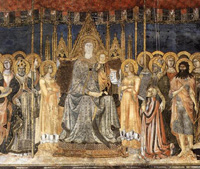
|
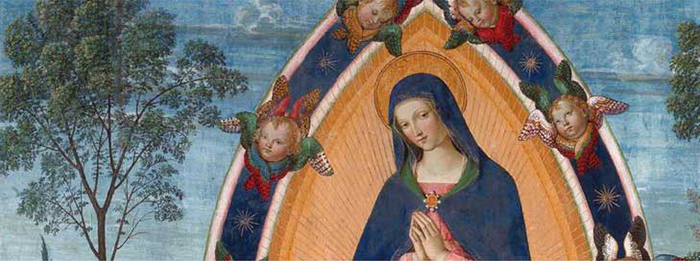 |
Pinturicchio, The Ascended Virgin with Sts Gregory the Great and Benedict, 1512, tempera on wood, 282 x 198 cm, Museo Civico, San Gimignano
|
The gallery itself is on the second floor and contains works by Coppo di Marcovaldo, Lippo Memmi, Benozzo Gozzoli, Filippino Lippi, Il Sodoma, Pinturicchio, Azzo di Masetto, Niccolò di Ser Sozzo; Taddeo di Bartolo, Lorenzo di Niccolò, the so-called Master of 1419, and Benedetto da Maiano.[8]
The first room is called The Trinity, due to a painting on this topic (1497) by Pier Francesco Fiorentino. It also houses a Madonna and Child with Saints by Leonardo da Pistoia and a Pietà by Bastiano Mainardi.
Other rooms contain a Maestà from the late thirteenth century, altar decorations by Memmo di Filippuccio, a Madonna and Child by Vincenzo Tamagni (1528), several Gothic altarpieces (including one showing scenes from the life of Saint Gimignano), a Madonna with Saints Gregory and Benedict by Pinturicchio, and two medieval crucifixes of the Florentine school.
The Podestà apartments (Camera del Podestà) are frescoed with matrimonial scenes of a couple taking a bath and going to bed. (An unusual work by Memmo di Filippuccio dated to the early 14th century.)[5]
Museo Civico of San Gimignano is part of Museum System of "Fondazione Musei Senesi".
Palazzo Municipale - Art Gallery - Torre Grossa
Piazza Duomo, 2 - 53037 San Gimignano (SI)
Opening times:
• 1st November 2012 - 31st March 2013
every day, 11am-5.30pm, excluding January, 1st (opening time 12.30-5.30pm) and December, 25th (closed)
• 29th March 2013 - 30th September 2013
every day, 9.30am-7pm
• 1st October 2013 - 31st December 2013
every day, 11am-5.30pm, excluding December, 25th (closed)
|
|
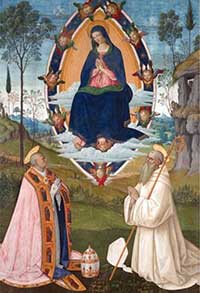
Pinturicchio, The Ascended Virgin with Sts Gregory the Great and Benedict, Museo Civico, San Gimignano |
Frescoes with matrimonial scenes by Memmo di Filippuccio
|
|
|
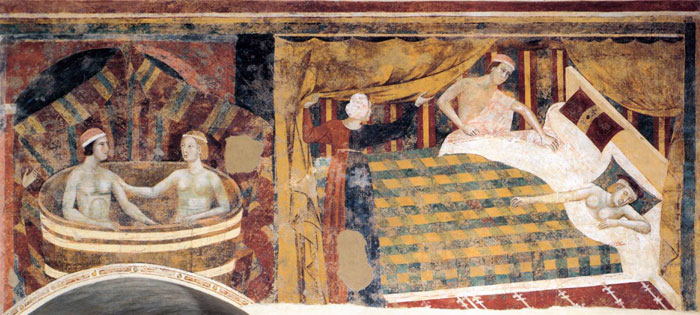 |
Memmo di Filippuccio, Erotic scenes, 1300-10, fresco, Palazzo del Podestà, San Gimignano
|
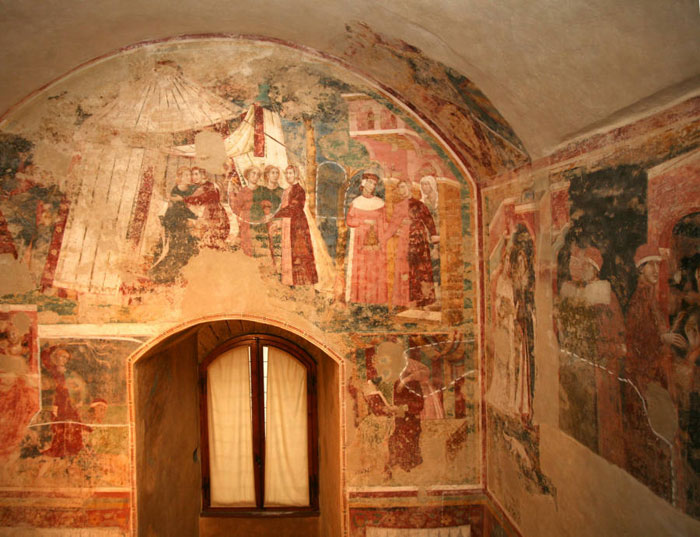 |
Memmo di Filippuccio, Frescoes with matrimonial scenes (before the restauration), Palazzo del Podestà, San Gimignano
|
 |
Memmo di Filippuccio, Frescoes with matrimonial scenes, Palazzo del Podestà, San Gimignano
|
|
|
|
![]()
![]()
![]()
![]()
![]()

